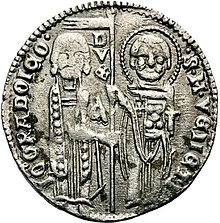
Leonardo Loredan was a Venetian nobleman and statesman who reigned as the 75th Doge of Venice from 1501 until his death in 1521. A wartime ruler, his dogeship was one of the most important in the history of Venice. In the dramatic events of the early 16th century, Loredan's Machiavellian plots and cunning political manoeuvres against the League of Cambrai, the Ottomans, the Mamluks, the Pope, the Republic of Genoa, the Holy Roman Empire, the French, the Egyptians and the Portuguese saved Venice from downfall.

Agostino Barbarigo was Doge of Venice from 1486 until his death in 1501.
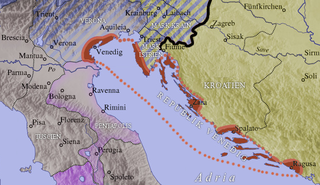
The Republic of Venice was a sovereign state and maritime republic in Northeast Italy, which existed for a millennium between the 8th century and 1797.
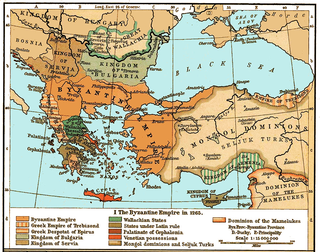
The War of the Euboeote Succession was fought in 1256–1258 between the Prince of Achaea, William of Villehardouin, and a broad coalition of other rulers from throughout Frankish Greece who felt threatened by William's aspirations. The war was sparked by Villehardouin's intervention in a succession dispute over the northern third of the island of Euboea, which was resisted by the local Lombard barons with the aid of the Republic of Venice. The Lord of Athens and Thebes, Guy I de la Roche, also entered the war against William, along with other barons of Central Greece. Their defeat at the Battle of Karydi in May/June 1258 effectively brought the war to an end in an Achaean victory, although a definite peace treaty was not concluded until 1262.

Reniero Zeno was the 45th Doge of Venice, reigning from 1 January 1253 until his death in 1268.
The Venetian–Genoese Wars were a series of struggles between the Republic of Genoa and the Republic of Venice, at times allied with other powers, for dominance in the Mediterranean Sea between 1256 and 1381. There were four bouts of open warfare, in which the fighting between the two republics took place largely at sea. Even during periods of peace, incidents of piracy and other minor outbreaks of violence between the two trading communities were commonplace.
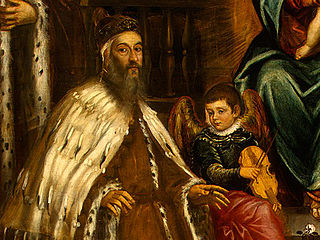
There were three Doges, and many other prominent Venetians, called Alvise Mocenigo. Alvise I Mocenigo was doge of Venice from 1570 to 1577.

Giovanni Dandolo was the 48th Doge of Venice, elected late in his life on 31 March 1280, died on 2 November 1289. During his reign the first Venetian gold ducat was introduced into circulation.

Pietro Gradenigo was the 49th Doge of Venice, reigning from 1289 to his death.

Andrea Vendramin served as Doge of Venice, 1476–78, at the height of Venetian power, the only member of the Vendramin family to do so. His mother, Maria Michiel, and his wife Regina Gradenigo, both came from Dogal families. He had served as Venetian Procurator in Rome, and his brief reign was largely concerned with the end of the Second Turkish–Venetian War. He probably died of plague.
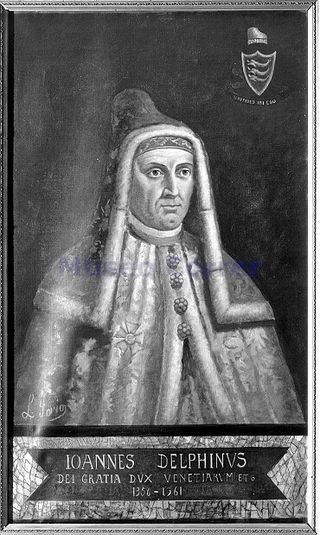
Giovanni Dolfin, also known as Giovanni Delfino or Delfin was the fifty-seventh Doge of Venice, appointed on August 13, 1356. Despite his value as general, during his reign Venice lost Dalmatia. He was blind from one eye after a wound received in battle.
Giovanni Bembo was the 92nd Doge of Venice, reigning from his election on 2 December 1615 until his death. His reign is notable for Venetian victories during the War of Gradisca (1617) and for the Bedmar Plot (1618), in which the Spanish ambassador to Venice, Alfonso de la Cueva, 1st Marquis of Bedmar, was unsuccessful in his plans to destabilize the Most Serene Republic.

Francesco Erizzo was the 98th Doge of Venice, reigning from his election on 10 April 1631 until his death fifteen years later. His reign is particularly notable because the last year of his reign saw the beginning of a war with the Ottoman Empire for control of Crete that would last for 24 years and dominate the geopolitics of the Mediterranean.
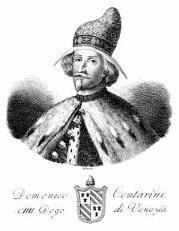
Domenico II Contarini was the 104th Doge of Venice, reigning from his election on October 16, 1659 until his death.

Marcantonio Giustinian was the 107th Doge of Venice, reigning from his election on January 26, 1684 until his death. Giustiniani was the quintessential Doge of the Republic of Venice, taking little interest in affairs of state. He had little role in the conduct of the Morean War (1684-1699), which was raging during his time as Doge, though a number of military victories were secured by provveditore Francesco Morosini, who would later be Giustinian's successor as Doge.

Silvestro Valier or Valiero was the 109th Doge of Venice, reigning from his election on 25 February 1694 until his death six years later. The Morean War between the Republic of Venice and the Ottoman Empire, which had been ongoing since 1684, came to an end during Valier's reign as Doge, in January 1699.
This article presents a detailed timeline of the history of the Republic of Venice from its legendary foundation to its collapse under the efforts of Napoleon.

The Coinage of the Republic of Venice include the coins produced by the Republic of Venice from the late 12th century to 1866. After this date, coins were still produced in Venice.
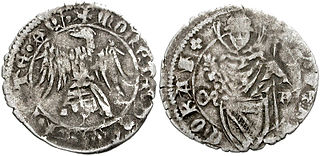
Marquard of Randeck was Patriarch of Aquileia from 1365 until his death.
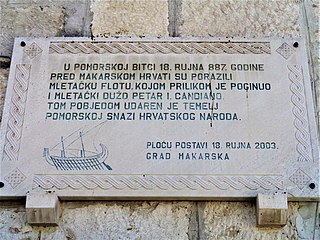
The Croatian–Venetian wars were a series of periodical, punctuated medieval conflicts and naval campaigns waged for control of the northeastern coast of the Adriatic Sea between the City-state of Venice and the Principality of Croatia, at times allied with neighbouring territories – the Principality of the Narentines and Zahumlje in the south and Istrian peninsula in the north. First struggles occurred at the very beginning of the existence of two conflict parties, they intensified in the 9th century, lessened during the 10th century, but intensified again since the beginning of the 11th century.
